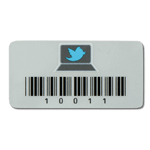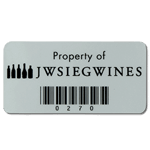
Asset Labels
Asset Labels are available in a range of materials and finishes to suit the particular application, for example IT assets, equipment that is used outdoors and even asset labels for use in maritime applications that must be resistant to salt water and abrasion.
Polyester Asset Labels
Polyester Asset Labels are a durable and very popular label in Asset Tracking Solutions where the Asset is located indoors. Our polyester asset labels and tags have a protective over-laminate to shield against abrasion. The permanent pressure-sensitive adhesive provides ensures that the asset labels always remains in place.

Premium Polyester Asset Labels
Premium Polyester Asset Labels are highly durable and very popular in Asset Tracking Solutions. Our polyester asset labels and tags have a protective over-laminate to shield against chemicals and abrasion. The permanent pressure-sensitive adhesive provides ensures that the asset labels always remains in place.

Metal Asset Tags
Metal Asset Tags are a very popular and an extremely durable asset tag, made from 100% 3.0 mil anodized aluminium, with high performance adhesive or holes for mechanical attachment. These Metal Asset Tags are used in environments where they are exposed to extreme temperatures, frequent abrasion and chemicals. The graphics are sealed into the anodized layer creating a very durable metal asset tag. These tags with work even when exposed to water, dirt, chemicals, sunlight, solvents and temperatures up to 343° C. Teflon® treatments are added if a customer needs to be able to resist paint. Metal Asset Tags have a 30-year life outdoor.
Companies such as power, water, and gas suppliers rely on metal asset tags and use them in a vast range of applications from pole tags to track the inspection and treatment of each pole, to equipment tags that are used in power generation plants to manage maintenance and inspections for computerized maintenance management systems(CMMS).
Metal Asset Labels
Consider the following when choosing a metal asset label:
- Long Lifetime. Even in extreme outdoor environments, aluminium labels can last for more than 20 years. This performance is among the best in the industry. Alumimium is a materials that can perform well in a wide range of environments. They’re also a popular choice in highly regulated industries, such as aerospace or defence. An Excellent solution where stringent asset tracking or item tracking is needed.
- Durability. aluminium is the perfect label choice for demanding applications that may encounter a wide variety of environmental conditions. With resistance to chemicals, moisture, temperature, UV rays, and abrasion, they can be used just about anywhere. They are often selected for use on marine vessels and oil rigs which spend long periods of time at sea. Even under these extreme situations, these labels are dependable and remain readable and intact.
- Image Clarity. The standard black-on-silver design of most aluminium labels provides clear, crisp graphics that are easy to read. Since the graphics are protected beneath an anodic layer, they are less likely to become damaged from any exposure to harsh conditions. In addition, the clean and professional look makes these labels a high-quality choice for any factory, warehouse, or industrial operation.
- Anodized aluminium labels have crisp black graphics sealed beneath an anodic layer of the aluminium to provide superior image quality and durability, whereas anodized aluminium labels with graphics of any colour residing beneath a surface layer offer the same image resolution quality and durability. Screen-printed aluminium labels have images screen-printed onto the surface of the aluminium and are subject to abrasion and fading.
GET MORE INFORMATION
Asset Labels – Asset Tracking Projects
Using the Correct Asset Labels is the key implementing a successful Asset Tracking Project. Whether they are a Laptop Asset Tag, Tamper Proof Asset Labels, Polyester Asset Labels or Metal Asset Labels, the asset labels must be designed and manufactured to be used in the environmental conditions that they will be expected to work in. We work with you to design a custom asset tag or label for your needs. With our experience and expertise we have the capability to fully understand your requirement. We design a solution to meet those requirements. The result are asset labels that will work in your environment. Whether it’s polyester asset labels for general asset tracking applications or metal asset labels that must work for up to 25 years in harsh conditions.
Designing Custom Asset Tags
So what do you need to consider when designing a custom asset tag or asset label? There are a wide range of issues to be considered, including:
- Asset Label Size ?
- Is there a need for outdoor usage ?
- Is there a need for indoor usage ? for example a laptop asset tag
- What is the lowest temperature that the asset label / asset tag will be exposed to?
- What is the highest temperature that the asset label / asset tag will be exposed to?
- What is the life expectancy of the asset label / asset tag ?
- How will the asset tags / labels attached? Do you need Holes for rivet, screw or to hang with a tie.
- Do you need special stronger adhesive for the asset label?
- Are Chemical spills likely in the operating environment?
- Will the asset label be subject to Abrasion ? What level of abrasion protection is needed? High, Medium, Low(none)
- Are there any other environment issues that need to be considered for this asset tracking application?
IMEC Media has provided Barcode Asset Labels to identify equipment and assets in a wide range of industries including Utilities, Manufacturing, Government, Universities, Colleges, Cruise Ships, Banking and Retail. Our products include:
Custom Asset Tags – Examples
- Lenovo Asset Tags
- Standard Laptop Asset Tags
- Waterproof Asset Labels
- Fixed Asset Labels both indoor and outdoor usage
- Tamper Proof Asset Labels
Aluminium Asset Tags
Aluminium asset tags are generally use in applications where there is a need for the tag to have a very long life, more than 20 years. These applications are normally outdoors or in very harsh conditions, such as chemical spills, assets that get rough treatment or lots of abrasion.
When Aluminium asset tags are made the barcode and the number or text are printed into the Aluminium. This is done so that no matter what wear or tear the tag is given throughout its life the barcode can always be scanned. Some uses for aluminium asset tags are:
- Telecommunications or Power Poles
- Fire Pumps
- Vehicles
- Power Equipment
- Cages
- Trolleys
- Tool Cribs
Types of Asset Labels and Asset Tags
There are many different applications where Metal Asset Labels and Tags can be used to improve efficiency and provide accurate data collection. These applications can be in any industry. Here are some examples:
Foil Asset Labels : Excellent in applications where there may be un-even surface or a curved surface. These asset labels are applied with a high performance permanent adhesive. Foil Asset labels provide a very flexible identification solution.
Rigid Asset Labels: Usually used when tracking assets that move regularly or assets that are outdoors or in harsh environments.
Pallet Barcode labels: Metal asset labels are used on plastic reusable pallets to identify the pallet, commonly used in chemical and pharmaceutical industries.
Teflon Coated Aluminum asset labels: These are used in applications where there is a need for additional protection against paint or chemicals.
What are Asset Labels?
Asset Labels identify equipment using a unique serial number or barcode. Asset labels or tags are typically labels that have an adhesive backing. Common asset label materials are anodized aluminum or laminated polyester. Common designs include the company logo and a border that provides contrast to the equipment. Barcodes are used on asset labels and tags to speed data entry and to reduce field entry errors. The function of asset tags has changed – to accommodate ever smaller, more mobile and more valuable assets. As a result, asset tags have changed – to be more smaller, more tamper resistant and to become more closely integrated with asset tracking software. Asset labels have four basic functions:
- Track Equipment. Where’s my asset? Tags are used to track as they move from tool crib to construction site, from loading dock to lab or just from room to room. Asset tags must stay with the asset itself – over its lifetime. Use for check-in / check-out.
- Inventory Control. What assets do we own? Whether a school must comply with Title II funding rules or a business to tie down purchases to meet Sarbanes Oxley traceability requirements, asset tags are the critical link as you perform periodic audits of your asset list and calculate the value of the asset over it’s lifecycle.
- Prevent Theft. Could you return the asset? Make it easy for anyone to return a valuable laptop or instrument to the proper owner. Prevent “accidental” misappropriation of you asset by another department.
- MRO Information. What maintenance needs to be done? Scanning a barcode can quickly bring the user to a data base of repair instructions or maintenance schedules.
Why Are Asset Labels Important?
- Asset labels or tags are the foundation of an asset tracking system, providing a reliable method for identifying individual assets and an efficient means of capturing data. Without asset tags, information on the asset’s location and history must be documented manually, a process that’s rife with human error and prone to inaccuracy. Assets are more likely to be misidentified when relying on manual processes, as well, resulting in unreliable data.
- Affixed to assets using permanent, pressure-sensitive adhesive or mechanical attachments, asset labels are meant to remain attached and readable throughout the usable life of an asset. Because asset labels are used to mark assets that can remain in use for decades, it’s crucial to consider the operating environment when choosing asset tags.
- While barcodes can be printed on peel-and-stick labels, these paper-based labels aren’t durable enough to withstand exposure to rain, snow, and UV over several months or years. Asset tags that fall off, fade, or otherwise become unreadable must be replaced, resulting in higher costs throughout the life of the asset compared to choosing a durable asset tag that can withstand the asset’s typical environmental conditions from the start.
